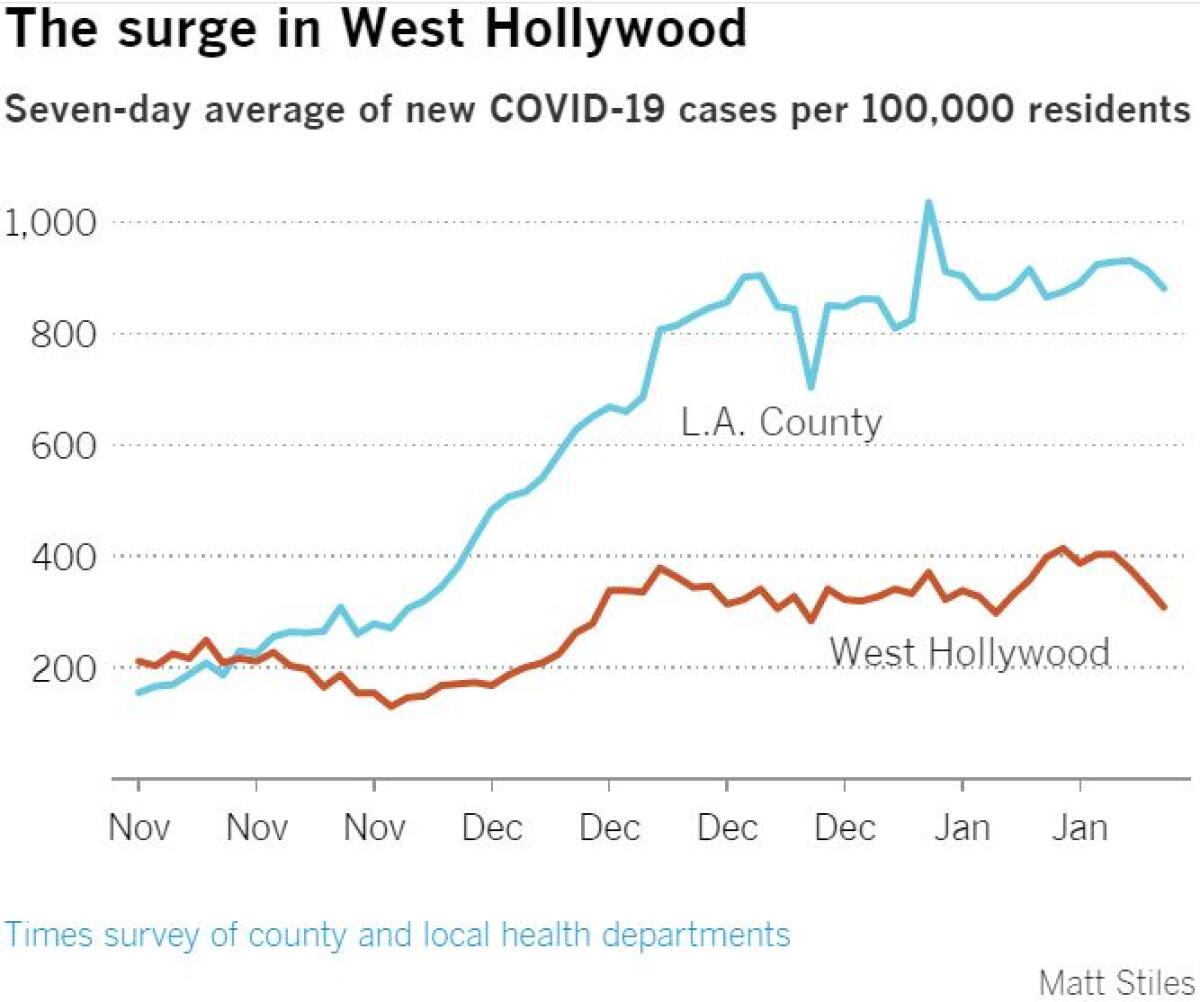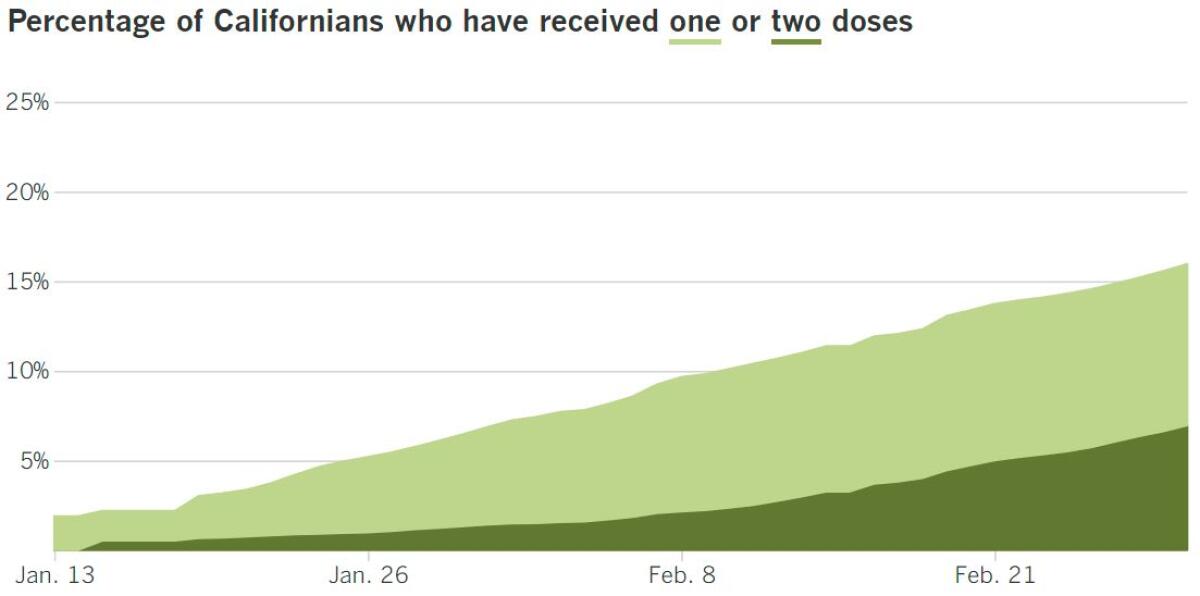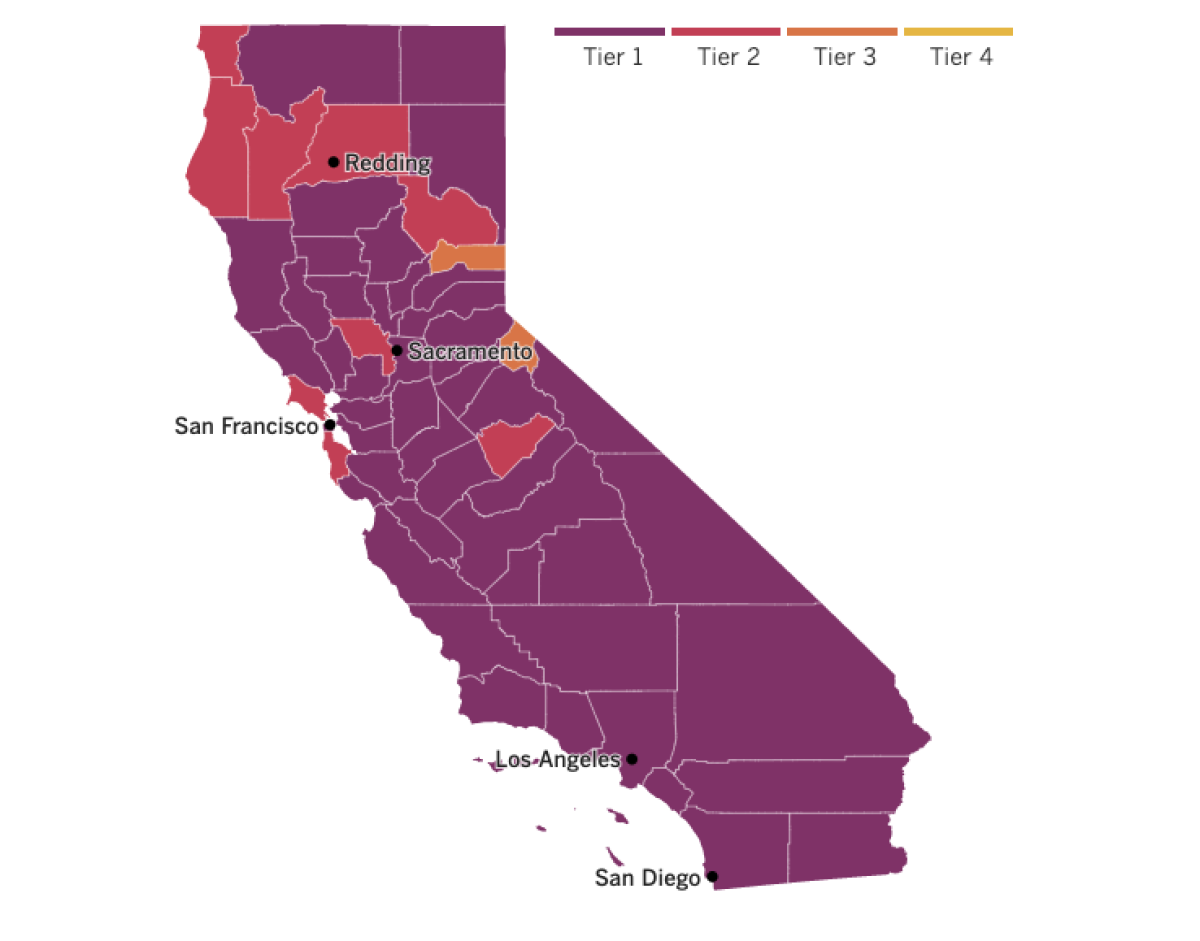Coronavirus Today: Three places the surge spared
- Share via
Good evening. I’m Thuc Nhi Nguyen, and it’s Monday, March 1. Here’s what’s happening with the coronavirus in California and beyond.
Real estate is all about location, location, location. The same seems to apply to the pandemic.
While L.A. County’s overall coronavirus case rate skyrocketed by 450% during the holiday surge, there were certain neighborhoods that saw nothing more than a brief blip on the radar. My colleagues Matt Stiles and Hayley Smith report on three of those surge-safe communities: West Hollywood, Malibu and Playa del Rey.
The fact that these communities are generally more affluent than the areas that suffered the most is hardly a coincidence. Most people who have avoided the coronavirus’ wrath have jobs that allow them to work from home. They aren’t living in overcrowded apartments with multiple generations of family members. They have easy access to outdoor space, where the virus’ strength is diminished.
But wealth wasn’t the only thing these communities have going for them.
Take West Hollywood, where social programs may have helped curb the spread of the coronavirus. The city of 36,000 provided free grocery and meal delivery for vulnerable residents, expanded assistance for renters and small businesses, and came up with new ways to use technology to stay in touch with people.
“We’re a small city,” said a real estate developer who lives there. “West Hollywood is good at communicating policies and getting the information out.” The payoff: The city’s case rate increased by only 46% during the two-month surge.

In Malibu, there were concerns that an influx of tourists to the city’s beaches and hiking trails would threaten the advantage gained by the area’s lack of density. So leaders took action in November, just in time for the surge.
To encourage healthy behavior, the Malibu City Council passed an ordinance requiring the use of masks, enforcing it with a $50 fine that can be avoided if the person in violation complies immediately. The infection rate only doubled in Malibu, while the rate for the county as a whole more than quadrupled.
And then there’s Playa del Rey, where infection rates actually fell by 25% between Nov. 15 and Jan. 15. The affluent beachfront neighborhood near LAX is largely residential, and has a high percentage of white-collar workers who presumably have the advantage of working from home. Given the lack of infections there, it seems that many residents have been doing just that.
One of them is Shayna Moon, a project manager for a technology company who has been working at home since April. When she does venture out for groceries, she always wears a mask. “I assume very little risk on a daily basis,” she said. “I’ve basically been insulated from it because of the demographic that I’m in.”
Another sign that people in Playa del Rey are taking the pandemic seriously: Sales at Playa Provisions, a well-known eatery just off the beach, are down by 75%.
By the numbers
California cases, deaths and vaccinations as of time and day of week:

Track California’s coronavirus spread and vaccination efforts — including the latest numbers and how they break down — with our graphics.

Across California
With coronavirus cases declining in recent weeks, Gov. Gavin Newsom has encouraged local officials to open elementary schools where possible. Now the governor and state legislators are offering more than just a pat on the back to school districts that follow through. They’ve agreed to a $2-billion deal to reopen schools that offers districts incentives to get kids back on campus.
Under the agreement announced Monday, the state will set aside $2 billion to help bring back in-person instruction in counties with fewer than 25 new daily coronavirus cases per 100,000 residents, my colleagues Taryn Luna and John Myers report. (Almost all California counties meet this threshold.) The money will help districts pay for personal protective equipment, ventilation upgrades, coronavirus testing and other expenses to enhance school safety.
To get the full funds, a district in a qualifying county must have all its public schools offering in-person instruction to all its students in transitional kindergarten through second grade, as well as to its high-needs students in all grades, by April 1. Districts will lose 1% of eligible funds every day thereafter if they do not.
School districts in counties in the state’s red tier, with seven or fewer new cases per day per 100,000 residents, must extend classroom learning to all elementary school students and at least one grade of middle or high school to access the full funds.
Though the money is intended to provide a powerful financial incentive for local education officials to reopen their schools, the bill does not require them to do so. The legislature is expected to vote on the bill this Thursday.
The governor also wants lawmakers to set aside another $4.6 billion for services like summer school, tutoring and mental health counseling to help make up for learning loss linked to remote instruction over the past year.
One major hurdle stopping the L.A. Unified School District from moving forward with in-person classes was cleared Monday when state and local officials confirmed that the district will get 25,000 doses of COVID-19 vaccine by the end of next week. It would be enough to inoculate the staff needed to reopen its elementary school campuses.
But negotiations between the district and United Teachers Los Angeles could still delay reopening, which was originally set for April 9. That date has now been moved back to “mid-April.”
Teachers in L.A. County were among the 1.2 million people newly eligible to receive vaccines on Monday, joining workers in child care, emergency services and food and agriculture, including grocery store employees. Supply is still expected to be low, however.
Some education workers in L.A. County didn’t wait until Monday, however. At least three private schools offered employees ways to get vaccinations by stretching the eligibility rules, my colleague Howard Blume reports.
Administrators at Westmark School in Encino and Mirman School in Brentwood wrote verification letters for their employees saying they were responsible for healthcare-related duties that could make them eligible for inoculation, but four staff members said the letter did not appropriately describe their roles or those of most others at the school.
Alverno Heights Academy, an independent Catholic school, gave its employees access codes meant for people from the hardest-hit communities, noting a loophole that said the code could be used at the Cal State L.A. vaccination site for “education and childcare workers.” The same guidance also stated: “The focus of these vaccination sites is to provide equitable access to safe, life-saving vaccines to California communities that have been heavily impacted by COVID-19.”
The tactic left at least one employee questioning the school’s dedication to its mission. “We’re trying to live out what Jesus would want us to do, and Jesus would not want us [to do this],” an Alverno Heights employee said. “This is a morally wrong thing that goes against everything we stand for as a school.”
While most schools are just restarting elementary school classes, Alverno Heights and Westmark are already bringing back high schoolers.
Opening campuses to older students has caused tension within a school district south of San Francisco, providing a glimpse into possible future conflicts for the rest of the state, my colleague Susanne Rust reports.
When San Mateo County moved to the red tier last week, high schools were allowed to open with strict limits on distancing, ventilation and classroom capacity. Sequoia Union High School District leaders announced a plan to reopen on April 5, with students returning to campus for a term scheduled to end June 4. Four small groups of students would return to campus on a rotating basis for two days a week, every two weeks. Teachers would help students in their classrooms while simultaneously instructing those learning remotely.
Although the plan was agreed to by district officials and the Sequoia District Teachers Assn., not everyone is on board with potential risks required for what would amount to a two-month term. In a message to his junior-level U.S. history class, one Menlo-Atherton High School teacher wrote: “If u don’t want this to be happening, I will highly encourage you to encourage your parents to go full karen on the school and at the school board meeting.”
Meanwhile, a student at the same school expressed support for the reopening. “It’s not ideal,” said Sathvik Nori, a senior and the school board’s student trustee. “But we should think of it as trial period. A time to iron out the kinks, so when school starts this fall, things will be smoother.”


See the latest on California’s coronavirus closures and reopenings, and the metrics that inform them, with our tracker.
Consider subscribing to the Los Angeles Times
Your support helps us deliver the news that matters most. Become a subscriber.
Around the nation and the world
Americans will have a third vaccine starting this week, as nearly 4 million doses of the newly authorized Johnson & Johnson vaccine will arrive in states for injections starting Tuesday.
The Food and Drug Administration granted emergency use authorization for the one-shot vaccine Saturday, and the entire stockpile shipped out Sunday night. J&J plans to deliver about 16 million more doses by the end of March and 100 million total by the end of June.
The vaccine, developed by J&J’s Janssen unit, is about 66% effective at preventing COVID-19 and 85% effective at preventing severe cases of the disease, data suggest. All 22 independent experts on an FDA advisory panel endorsed the J&J shot for use in adults after a day-long review on Friday.
The COVID-19 vaccines already authorized in the U.S. — one developed by Pfizer and BioNTech and one from Moderna — were at least 94% effective at preventing COVID-19 in their clinical trials. But the J&J vaccine was tested under quite different circumstances, so it’s not an apples-to-apples comparison. The J&J vaccine also has the logistical advantage of requiring just one shot instead of two.
Dr. Anthony Fauci, the nation’s top infectious-disease expert, and Dr. Marcella Nunez-Smith, the chair of the White House equity task force, encouraged Americans to take the first COVID-19 vaccine available to them, regardless of manufacturer.
Experts say it’s especially important to vaccinate people as quickly as possible to head off the threat from a growing number of potentially troublesome coronavirus variants.
Researchers at Caltech and Columbia University are studying yet another new variant that has turned up in New York, New Jersey and Connecticut. Scientists say it’s too soon to know how problematic the new variant is, but this weekend, Fauci called it and the California variant “worrisome.”
Although the number of new coronavirus cases has declined in recent weeks, federal officials are noticing that the improvements may have stalled. That’s prompting experts to warn states against relaxing their COVID-19 restrictions too soon, my colleague Rong-Gong Ling II reports.
Last Tuesday, the nation’s seven-day average of new coronavirus cases per day was 65,426. By Sunday, that number had risen to 66,594, according to the Centers for Disease Control and Prevention.
A variant from the United Kingdom that is about 50% more transmissible than earlier coronavirus strains may be partly to blame for the rise in cases, said CDC director Dr. Rochelle Walensky. The U.K. strain now represents an estimated 10% of coronavirus cases nationwide, up from between 1% to 4% a few weeks ago.
“The virus is not done with us,” Walensky said. “We cannot get comfortable or give into a false sense of security that the worst of the pandemic is behind us. Not now, not when mass vaccination is so very close. I know people are tired. They want to get back to life to normal, but we’re not there yet.”
Officials at the World Health Organization echoed that sentiment Monday. Dr. Michael Ryan, director of WHO’s emergency program, said it was “premature” and “unrealistic” to think the pandemic might be stopped by the end of the year. But, he added, “if we’re smart, we can finish with the hospitalizations and the deaths and the tragedy associated with this pandemic” by that time.
In Israel, which has executed the world’s fastest vaccine rollout so far, officials are trying to coax the last vaccine holdouts to get inoculated. Some of the methods seem gentle, like offering free drinks. Others are stronger.
Legislation passed last week permits the health ministry to provide cities with the names, addresses and contact information of residents who have not been vaccinated. City workers are allowed to use the information to contact those people and try to convince them to get vaccinated.
The law came under fire from civil rights groups and privacy advocates, who warned that it sets a dangerous precedent of violating medical confidentiality.
Everyone in Israel over 16 is eligible for to receive a COVID-19 vaccine, but the lowest rates of vaccination are among ultra-Orthodox Jews, Arab citizens and younger Israelis.
Your questions answered
Today’s question comes from readers who want to know: Is it OK to mix and match doses from different COVID-19 vaccines?
Some mixing and matching during the pandemic works — like the combination of a surgical mask covered by a cloth mask, for example — but it’s not recommended for vaccines at this point.
The CDC’s Advisory Committee on Immunization Practices does not state a preference between the currently available Pfizer-BioNTech and Moderna COVID-19 vaccines, which are both intended to be administered in two-dose regimens. But the CDC adds “these mRNA COVID-19 vaccines are not interchangeable with each other or with other COVID-19 vaccine products.” (The emphasis comes from them.)
“The safety and efficacy of a mixed-product series have not been evaluated,” the guidance continues. “Both doses of the series should be completed with the same product.”
But with an unreliable supply chain, a growing number of variants emerging and more vaccines joining the market, there may be some benefits to a mix-and-match strategy. Vaccinologists from Oxford University are investigating it now, my colleague Melissa Healy reports.
The researchers will test various combinations and time intervals of the Pfizer-BioNTech and Oxford-AstraZeneca vaccines, the shots currently being used in Britain now.
Scientists were encouraged by results from experiments in mice showing that combinations of the Pfizer and AstraZeneca vaccines boosted immunity better than two doses of either one alone.
Both vaccines prime the immune system to target the coronavirus’ spike protein, but they focus on different parts of the spike, and they do so in different ways. The AstraZeneca one uses a modified cold virus to present the spike protein to the immune system, while the Pfizer one hands over genetic instructions for making the spike protein and relies on human cells to produce it.
In theory, a combination of vaccines that activates the immune system in multiple ways could kick the body’s defenses into a higher gear. In addition to killing virus particles as they circulate in the bloodstream, the immune system could become better equipped to destroy cells that have already been infected and turned into virus-copied factories. The Oxford researchers expect to release their findings in June.
We want to hear from you. Email us your coronavirus questions, and we’ll do our best to answer them. Wondering if your question’s already been answered? Check out our archive here.
Resources
Need a vaccine? Keep in mind that supplies are limited, and getting one can be a challenge. Sign up for email updates, check your eligibility and, if you’re eligible, make an appointment where you live: City of Los Angeles | Los Angeles County | Kern County | Orange County | Riverside County | San Bernardino County | San Diego County | San Luis Obispo County | Santa Barbara County | Ventura County
Practice social distancing using these tips, and wear a mask or two.
Watch for symptoms such as fever, cough, shortness of breath, chills, shaking with chills, muscle pain, headache, sore throat and loss of taste or smell. Here’s what to look for and when.
Need to get tested? Here’s where you can in L.A. County and around California.
Americans are hurting in many ways. We have advice for helping kids cope, resources for people experiencing domestic abuse and a newsletter to help you make ends meet.
We’ve answered hundreds of readers’ questions. Explore them in our archive here.
For our most up-to-date coverage, visit our homepage and our Health section, get our breaking news alerts, and follow us on Twitter and Instagram.




